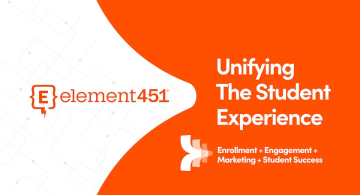6 Strategies for Increasing Student Engagement in Higher Education
by Erin Newton · Updated Nov 28, 2024

With millions of high school students applying to colleges every year, the process can easily feel distant and impersonal. Increasing student engagement in higher education requires intentional strategies to make connections meaningful. The sheer volume of incoming applications is high, and many colleges are strained for time and staff resources. Reaching out, following up, and delivering customizable experiences all help students stay engaged throughout enrollment.
According to the U.S. News and World Report, the number of applications that colleges receive has been steadily increasing over the last five years, particularly among first generation learners and students from minority groups. Students expect and deserve a first-rate experience that matches the level of their investment.
With these trends in mind, colleges and universities are faced with a high stakes problem—keep the student experience engaging, or lose out on enrollments. Let’s take a look at some workable strategies.
Strategies for Increasing Student Engagement in Higher Education
Now that we've seen how recruiting, admissions, and enrollment affect the student experience, let's look at some practical applications. Any strategy to encourage students must start with a clear understanding of your ideal student—who they are, what they hope to achieve in the learning process, and how your programs can help them get there.
From there, it’s all about designing creative initiatives that speak directly to student success, while showcasing the support structures at a particular campus. Technology solutions and platforms can help college leaders instill change and create more positive experiences for all.
1. Keeping Students Engaged with Multichannel Communication
As you work to keep students engaged, acknowledge how and where they spend their time, especially online. Students love convenience, flexibility, and speed when they research and look for admissions information.
If your school has the capacity to text, chat, email, and connect socially, you’re more equipped to provide students with the connections they're seeking.
Additionally, these options provide a consistent way to engage students outside of traditional business hours. Keep students in the loop at all times, and answer questions whenever they pop up. By doing so, you’ll keep the admissions wheels turning and generate more excitement.
2. Reduce Confusion and Chaos by Effectively Using Technology
Let’s face it—many schools use lots of outdated legacy applications to run their admissions, enrollment, and registrar processes. These are the administrative steps that students need to complete on the front end. But if your students are interacting with disjointed and outdated platforms, engagement suffers.
Eliminate confusion by choosing user-friendly tech that benefits everyone. From both a student and internal perspective, you’ll be able to reduce manual efforts and give everyone the data they need.
More admissions teams are also turning to AI-powered conversation tools to increase student satisfaction. With a platform like Element451, you can easily sync conversations from different places, giving students access to better answers about their account status in less time.
3. Engaging Students with a Student-First Marketing Approach
Students may not care if your campus has a long list of impressive facts and figures; they care about their own experiences. They want to know how a specific campus will change their lives, or how particular programs will prepare them for future careers.
To answer these questions and relate on a personal level, use stories, testimonials, and opinions from actual students. In addition to building trust and creating transparency, this content directly impacts engagement in admissions. When prospective students have the chance to interact with actual peers, they can better picture themselves in the same spot.
>> See how student-centered enrollment makes admissions easier! <<
4. Unveil Active Learning Techniques
When students start researching college, they want to know what to expect during the teaching and learning phase of their education. Preview the perks of attending your college or university based on its unique selling points.
Starting with the admissions process, introduce the options that are available once students enroll. For example, you might choose to highlight:
- Valuable, job-ready critical thinking skills that students will learn both in-class and throughout campus activities
- A mix of in person learning and virtual learning options that help students find flexibility
- Exclusive course materials that set academic programs apart from competitors
- Small groups and community support structures to help students build relationships and connections
5. Stimulate Thoughtful Discussions
Engagement thrives when students feel their voices matter. Create opportunities for thoughtful discussions that allow students to share their perspectives, ask questions, and dive deeper into topics that interest them. Host interactive webinars, panel discussions, or Q&A sessions where students can actively participate.
Leveraging forums or discussion boards in your admissions process can also help prospective students connect with peers and faculty early on, giving them a taste of your institution’s academic and cultural environment. Encouraging dialogue creates a sense of belonging and motivates students to stay engaged.
6. Honor Student Achievements
Recognition goes a long way in keeping students motivated and engaged. Highlighting student achievements—whether academic, extracurricular, or personal—fosters pride and a sense of accomplishment. Showcase these successes on your website, social media channels, or through newsletters to inspire others and create a culture of celebration.
For prospective students, consider implementing rewards or recognition programs throughout the admissions journey. Small gestures like congratulatory emails for application completion or personalized notes acknowledging milestones can make a big difference in how connected they feel to your institution.
Student Engagement During and After the Enrollment Cycle
The concept of student engagement tends to change depending on what part of the lifecycle you’re addressing. For example, engagement in the recruiting process is a different concept (with separate outcomes) than engagement for a student in the middle of their degree program or within the classroom environment.
For the sake of admissions and enrollment, we tend to think of an engaged student as one who is actively participating in all steps of the enrollment process and has the resources and communications they need to move forward. At this phase, the student is most likely working alongside a recruiter or admissions counselor to gain clear expectations about what comes next.
The Importance of Student Engagement During the Enrollment Cycle
Beyond the point of admissions enrollment, increasing student engagement focuses more on the individual’s interaction with the campus community. As we’ve mentioned before, the definition of engagement changes to be more in line with the description below.
“An engaged student or learner is one who actively participates in their educational journey. The engaged student finds relevance in their chosen field of study, connects their experiences to intended goals, and finds ways to become part of the broader community.”
Engaged students post-enrollment centers on collaborative learning within the campus community. It capitalizes on student interests, allowing students to build worthwhile relationships both in and outside of classroom activities.
The Importance of Student Engagement After the Enrollment Cycle
It is helpful to think about student engagement through the lens of classroom experiences, but engagement is not limited to academics. As a metric, colleges must measure the level of student engagement from the point of first interaction. Doing so often means looking closely at the "inner workings" of the admissions process—including how students feel about it.
If a school’s marketing and recruiting strategies fail to attract today's students (and convince them to apply), there’s already an engagement gap. Practical strategies are needed to relate and build strong relationships.
Future students want to hear messaging that speaks directly to them. They want to feel like a real person—not a number in line. They want reliable help and support, where and when they need it most.
When higher education institutions build marketing engines around these qualities, achieving high engagement becomes realistic.
Results of Strong Student Engagement
For schools that have high engagement standards during the recruiting and enrollment processes, it’s only natural to want to keep those results in the classroom. The results are also clear, as engaged students tend to perform better and actually complete their chosen degree.
As the Center for Community College Student Engagement points out:
“Student learning, persistence, and attainment in college are strongly associated with student engagement. The more actively engaged students are—with college faculty and staff, with other students, with the subject matter they are studying—the more likely they are to persist in their college studies and to achieve at higher levels.”
In other words, it’s never too early to start thinking about the impact that positive enrollment experiences have on a student’s future. That foundation of personalization, trust, and support often carries students to the finish lines of their degree programs, making an enormous impact both individually and collectively.
How to Measure Student Engagement?
To understand the practical effectiveness of your student engagement strategies, have several measurement tools in place. The most popular options for understanding engagement KPIs include:
- Qualitative student surveys (post-enrollment and at regular intervals)
- Student retention data
- Observations of the classroom environment
- Academic performance metrics (for correlation to engagement levels)
Admission offices can also measure engagement through application submission rates, event attendance, and interactions on digital platforms where they host information and events. These metrics help campus leaders identify which strategies are working with students and where improvement is needed to engage students in the future.
Increasing Student Engagement With an AI-Powered Platform
Even though “engagement” is in the name, a student-centered platform like Element451 helps schools connect the dots and create well-rounded strategies to keep students engaged from enrollment to graduation.
With a centralized place to record and keep student data, and a suite of tools designed to make marketing totally simple, it’s no wonder that institutions of all shapes and sizes rely on it. For example, Blinn College, a county-owned public college in Texas, saw a 10% enrollment increase and a 33% dropout decrease when converting to Element451.
These results happened because Blinn replaced a cumbersome tech stack with a single student-friendly platform, making it easier to streamline communication and become more efficient at every stage of the enrollment process.
Because of Element451, Blinn’s diverse body of students now benefits from:
- Having one point-of-contact in the recruitment cycle
- Getting access to detailed, effective messaging from admissions staff members
- Receiving reminders about timely payments and important deadlines
Overall, better engagement has been transformational to Blinn’s campus culture. This goes to show that when students are actively engaged in the admissions and enrollment cycles, the benefits extend for months and years to come.
>> Read Blinn College’s Student Engagement Success Story <<
Unlock the Power of Element451
In the admissions and enrollment realm, we all want to connect with applicants on a deeper level and see students respond to their own learning journey. Fostering engagement means going beyond basic application reviews and helping students visualize what a successful future looks like.
Invest in an engagement platform that pays off by elevating the student experience from the get-go. It's time for your school to stand out. Element451 can help.

About Element451
Boost enrollment, improve engagement, and support students with an AI workforce built for higher ed. Element451 makes personalization scalable and success repeatable.
Categories
New Blog Posts

The Definitive Guide
AI in Higher Education
Bridge the gap between the latest tech advancements and your institution's success.
Related Articles

Talk With Us
Element451 is the only AI Workforce Platform for higher education. Our friendly experts are here to help you explore how Element451 can improve outcomes for your school.
Get a Demo








